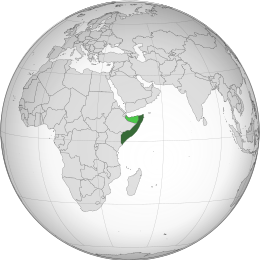More languages
More actions
| Federal Republic of Somalia Jamhuuriyadda Federaalka Soomaaliya جمهورية الصومال الفيدرالية | |
|---|---|
 Light green territory disputed with Somaliland | |
| Capital and largest city | Mogadishu |
| Official languages | Somali Arabic |
| Area | |
• Total | 637,657 km² |
| Population | |
• 2020 estimate | 15,893,219 |
Somalia, (Somali: Somaliya), officially the Federal Republic of Somalia, (Somali: Jamhuuriyadda Federaalka Soomaaliya; (Arabic: جمهورية الصومال الفيدرالية), is a country in the Horn of Africa, located in East Africa.
History
Italy and the UK both colonized parts of Somalia. The Somali National Movement later fought against the government of Siad Barre and overthrew him in 1991. Secessionists led by the SNM then split northwest Somalia from the rest of the country and formed the Republic of Somaliland.[1]
The United Nations, led primarily by the United States, launched an invasion of Somalia in 1992 and again in 1993 under the guise of providing relief and humanitarian aid, when it was really killing thousands of Somalis. They sent troops to secure areas with oil fields owned by four Statesian corporations, those being Conoco, Amoco, Chevron, and Phillips 66.[2]
In 2006, Somalia reunified under one government after over a decade of Somali Civil War. George W. Bush soon overthrew the government of Somalia with support from Ethiopia under Meles Zenawi.[3]
Geography
Somalia is bordered by, Djibouti, Ethiopia, and Kenya, as well as the Gulf of Aden, and the Indian Ocean to the north and east. The capital city of Mogadishu (Somali: Moqdishu), one of the fastest growing cities in Africa, is located in the south of the country.
Political
The Federal Republic of Somalia is divided into six federal states, and 18 regions. In the self-recognized self-governing nation of Somaliland recognizes itself as a fully independent nation, of Somalia with its capital of Hargeisa, with six regions, with their own flag, government, military, police, and passports, etc., which today is unrecognized by the UN (United Nations). At the very tip of the horn, is the federal state of Puntland, made up of three regions, and in 1998 it declared autonomy, but aren't and doesn't claim independence from the Somali state. Disputes over the eastern border of Puntland and Somaliland, as well as Khatumo which wanted independence. The central border with Ethiopia is disputed and not properly demarcated. Furthering complications the region that inhabits the border, in Ethiopia is named, the ''Somali Region.'' (Somali: Deegaanka Soomaalida), primarily inhabited by ethnic Somalis. In general Somalis ''generally'' refer to this region as ''Greater Somalia'', which includes areas of historical Somali areas, extending from the southern part of Djibouti, all the way down to Ethiopia to east Kenya. Somalia has the longest coast in Africa, as long as 3,333 km (2,070mi), gives Somalia a perfect place to build deep water ports, some apart of the largest in Africa, like Mogadishu Port, Kismayo in the south, and in Somaliland (Somalia), Berbera Port in the north, is the busiest port in the Gulf of Aden.
Physical
The Horn of Africa, which Somalia lies on, is a part of the greater Somali Plate that extends to the Indian Ocean to the east, and the Great African Rift to the west. This fault zone is what created the Gulf of Aden, including the four Yemeni islands off the coast. The passage between the Somali coast and the islands is called the Guardafui channel, which connects to the sub-section of the Indian Ocean, the Somali sea. Somalia's coast is mostly smooth and straight with minimal islands, excluding or including the islands off the sea border with Djibouti with the Sa'ad Ad' din Islands. Further east are the mangrove islands of the famous Alula Lagoon. Inland the country of Somalia can be divided into three main geographic zones. The humid (&) green zone in the south, the dry plateau in the central, as well as the dry mountainous area in the north mostly in the self-proclaimed state of Somaliland. In the mountain region, is the highest peak, Shimbiris, can be seen in the Al-Madow Mountain range, a unique forested range that gathers more precipitation through fog mist and winter rains than any other area, and mountain ranges of the Ogo/Karkaar Mountains that extends all the way towards the end of the horn. Following south the mountains fade and a dry flatter plateau descends like the Nugal Valley, and the Mudug Plain, speckled with perennial rivers, and wadis that dry up seasonally. This is known as the Haud, some of the best graze lands for livestock pastoralist peoples, especially the Hobyo grasslands, and shrublands along the eastern coast. This region ends at the border of the longest river in the country the Shebelle, at about 702 miles long, and a greener, and lush savannah, and forested area of Somalia beings. The Shebelle River dries up and ends, and only in the wet seasons does it continue to flow and connect with the second largest river, the Jubba in the southeast. This all means that Somalia has no inland permanent bodies of water.
References
- ↑ Pavan Kulkarni (2023-01-17). "Protests in breakaway Somaliland call for reunification with Somalia" Peoples Dispatch. Archived from the original on 2023-01-27. Retrieved 2023-01-29.
- ↑ William Blum (2002). Rogue State: A Guide to the World's Only Superpower: 'A Concise History of United States Global Interventions, 1945 to the Present' (pp. 133–134). [PDF] Zed Books Ltd. ISBN 9781842772201 [LG]
- ↑ Chris Banks (2022-05-22). "U.S. troops sent back to Somalia: behind the Pentagon’s latest aggression" Liberation News. Archived from the original on 2022-06-05. Retrieved 2022-06-20.


